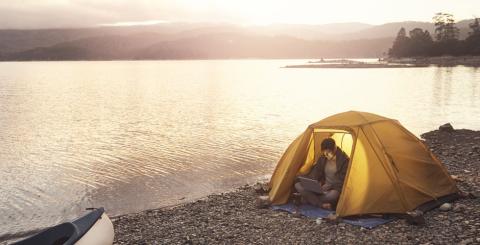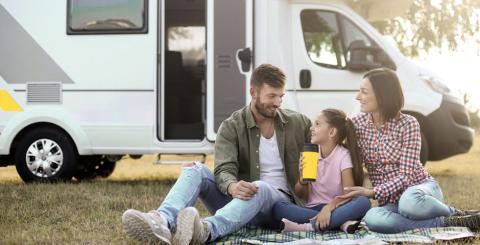Damage to your RV: covered or not?

Your RV is both a passenger vehicle and your home away from home. Given its size and what it’s used for, damage to it can be a big deal with a hefty price tag. To avoid being caught short in the event of a breakdown or accident, you need recreational vehicle insurance. Read on to find out what’s available.
What’s the right insurance for a recreational vehicle?
Recreational vehicles or RVs are used both to go places and to live in once you get there. As such, they all have certain features in keeping with their role as short-term accommodations when you’re on the road or away from home for a long or short time. RVs are divided into two main categories:
- Motorized RVs: RVs with an engine, where the driving and living sections are together in a single unit. These are referred to as self-propelled vehicles.
- Trailer RVs: RVs made to be towed by a car, truck, or other motorized vehicle that they’re hooked up to on a temporary basis.
Park models are a separate category from the two above and resemble a classic trailer but in widths of 8 to 16 feet. They’re designed for use as seasonal residences with only occasional towing. For insurance purposes, park units are treated as cottages, as they are not generally used on the road. Because they’re designed to stay where they are, insurers generally cover them with home insurance.
Motor vehicle insurance
The first layer of your recreational vehicle insurance is the coverage that applies to all motor vehicles: civil liability insurance. Civil liability insurance is mandatory and the minimum coverage amount in Québec is $50,000.
Civil liability insurance covers damage to your vehicle that you’re not at fault for, as per Québec’s Direct Compensation Agreement (DCA). It also covers you for accidental damages or injury you may cause to other people in Canada and the United States. Civil liability insurance protects you against financial losses you could incur if found responsible for physical damage or bodily harm to others.
Besides civil liability, you can also choose coverage for accidental damage to the vehicle you’re insuring, such as
- Comprehensive coverage
- Collision and upset coverage
- Coverage for perils other than collision or upset
- Specified perils coverage
All these types of coverage can be useful, so it’s up to you to decide what’s best for your needs.
Personal property coverage
The next layer of RV insurance is for your personal possessions. Since your RV is as much a place to live as a means of transportation, it probably has all kinds of stuff in it that you’ll want to protect. Comprehensive personal property insurance will do that for you.
Watch for exclusions and limitations on belongings that are temporarily out of the home (in your RV for the summer, for instance). For peace of mind, you’ll need to carefully assess your personal property and talk it over with your representative. Some options are available through your RV insurance and others through your home insurance.
Top-up insurance
The last layer of RV insurance is what’s called top-up insurance. As with any insurance, you should consider the optional benefits available. Optional benefits don’t cover you for accidents or damage, but they provide special services you may find helpful.
One option you can choose is (extended) travel cost coverage. It will pay your travel and accommodation expenses if a covered loss occurs—for example, the cost of getting home or staying in a hotel while your RV is in for repair.
Or there’s road service reimbursement coverage that pays for a tow truck and garage if your RV breaks down or is in an accident. It can also take the form of full-on roadside assistance delivered by your insurer.
How to buy RV insurance
Your trailer or motorhome is a recreational vehicle. That means your RV insurance will be designed to meet the criteria discussed above. But you should still get some things nailed down before you get RV insurance, for your own protection.
Pick your coverage
The first step is to choose the coverage that’s right for you. Have a look at the options available and make a list of the ones that seem most useful and most affordable. Some insurers offer specially designed RV insurance that will do most of what you want it to do. ProCaravaning insurance is one of those.
ProCaravaning offers coverage for your vehicle without depreciation if it’s less than 10 years old. It also includes personal property and third-party liability insurance as well as coverage for your lodging, meals, and transportation expenses if you’re in an accident while away from home.
Find out your premium cost will be
Once you’ve chosen your coverage, the next step is to find out what it’s going to cost. You can complete this step without actually purchasing a policy, but you’ll need to select all the coverage options you want in order to know the final premium amount. Other things are factored into the cost of your RV insurance as well, such as
- Your driver profile: You’ll pay less if you’re a careful driver and have the driving record to prove it.
- The type of vehicle and year of production: If your RV is new, you’ll likely have to pay more.
- Use: As is the case with all vehicles, u sing your RV a lot, racking up the kilometres, or living in a big city all increase risk—and with it the cost of your premium.
Along with these three factors, your choice of options also plays a role. You’ll pay more for comprehensive coverage than for a set of specified perils.
Reduce your insurance premiums
The final step in choosing your insurance coverage is to reduce your premium. There are things you can do to help you pay less. If you look back over the points we’ve discussed so far, you can probably see for yourself what the best strategy might be.
You can also reduce your premiums if you agree to a higher deductible. Insurers will also give you better premiums or better coverage if you bundle all your insurance with one provider. And there’s the tried-and-true approach of reducing your risk of accidents. All that takes is following certain safety rules for recreational vehicles (in French).
Risk-reduction advice for RV owners
Reducing the cost of your RV insurance isn’t just a matter of following our tips. You can also take steps to minimize your risk of having to make a claim, notably by reducing the chances of having your RV robbed or stolen or of experiencing problems while parking or towing.
Reducing theft and robbery risk
Reduce your risk of theft or robbery:
- Put in an anti-theft system or alarm
- Always lock all the doors
- Put away anything that’s easy to steal or likely to attract thieves’ attention
- Always park in protected or lighted areas
These measures will help make you safer, and make your insurer happy too!
Reducing other risks
Theft and robbery aren’t the whole story. Don’t forget the hazards of driving, parking, and towing your RV. There are plenty of things you can do to be safer. Before you get behind the wheel,
- Check that your headlights and taillights are working properly
- Check your tires
- Make sure your mirrors are securely attached
- Always check your load height and drive accordingly
- Make sure your hitch is securely fastened.
- Have a set of emergency equipment
Before you travel, take your RV in and get it inspected. And remember to check your brakes at brake check areas, where all RVs over three tonnes have to stop anyway. Together, these steps will help prevent breakdowns as well as accidents caused by mechanical problems.
To protect your RV, you need insurance designed for RVs. Use the advice here to help calculate your premiums, reduce your costs, and get the best insurance for your needs. And follow our tips to protect your RV and keep yourself safe.



